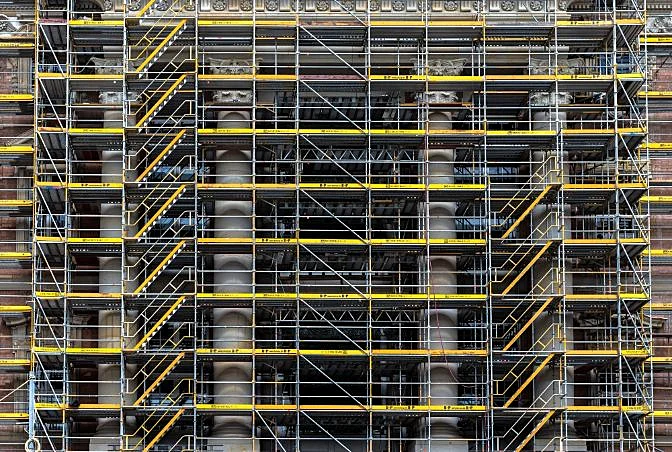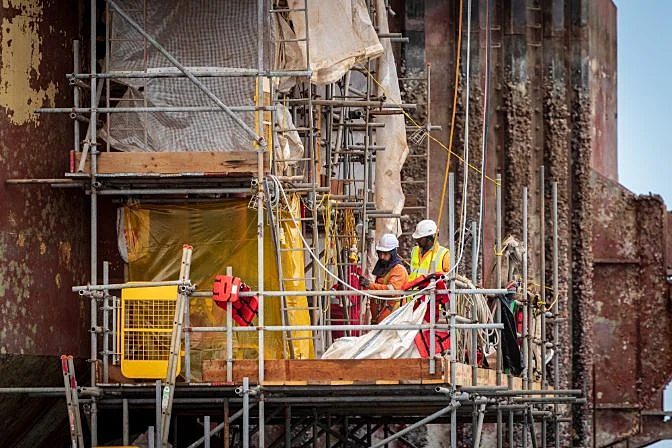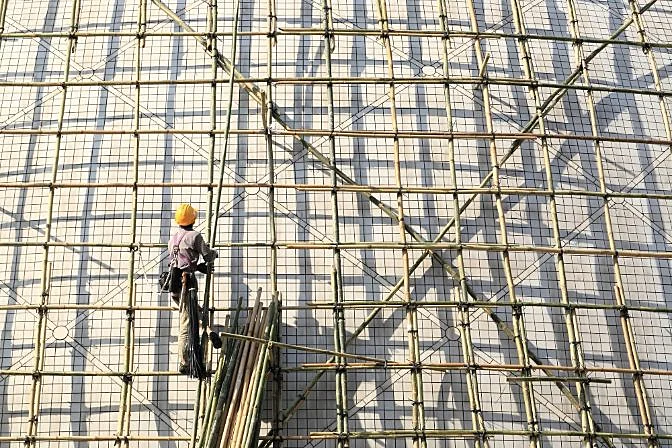What Is Scaffolding?
What Is Scaffolding?
Scaffolding is a temporary framework made from metal poles, wooden planks, or other materials, designed to support workers, inspectors, and cleaners who need to perform tasks at height. It provides a stable platform for people to work safely in areas that would otherwise be difficult or dangerous to access.
[Note: This article focuses on scaffolding as it relates to industrial and construction work. If you're interested in learning about scaffolding in an educational context, we recommend reading this article from Grand Canyon University.]
The history of scaffolding dates back thousands of years. Evidence suggests that early humans used simple structures to reach high places, even during the Stone Age. For example, there are indications that scaffolding-like systems were used over 17,000 years ago when creating the famous cave paintings in Lascaux, France.
Scaffolding has been used across various ancient civilizations, including in China and Egypt. Early versions were often constructed from wood and secured with ropes. These rudimentary setups allowed workers to reach elevated areas for construction, maintenance, and inspections.

In modern times, scaffolding has evolved significantly. Today, it comes in a variety of designs and is made from different materials, such as steel, aluminum, and even composite materials. It’s now more durable, easier to assemble, and safer than ever before.
This article will explore how scaffolding is currently used, its main components, how it's built, and the pros and cons of renting versus buying. We’ll also take a look at how new technologies, like drones, are changing the way inspections are conducted, reducing the need for scaffolding in many industries.
What Is Scaffolding?
A scaffold, also known as scaffolding or staging, is a temporary structure that allows workers to stand on a stable platform to perform tasks at height or in hard-to-reach locations. It supports both workers and materials during construction, maintenance, and repair projects on buildings, bridges, and other large structures.

The Benefits of Scaffolding
For thousands of years, scaffolding has remained a vital tool in construction and maintenance. It offers several key advantages:
- Access: Scaffolding provides stable access to nearly any part of a structure.
- Balance: It gives workers a secure footing, allowing them to move and work comfortably in different positions.
- Easy Assembly: Most scaffolding systems can be set up and taken down quickly, making them efficient for short-term use.
- Durability: Whether made from wood or steel, scaffolding is built to last through long projects.
- Safety: While not risk-free, scaffolding provides a stable base that helps reduce fall hazards. However, in the final section, we'll explore how drone technology is helping reduce the need for scaffolding altogether.
- Efficiency: Scaffolding can act as a bridge between different parts of a site, cutting down on unnecessary travel time for workers.
The Dangers of Working on Scaffolding
Despite its usefulness, working on scaffolding still carries risks. According to OSHA (the U.S. Occupational Safety and Health Administration):
- Scaffold-related accidents cause around 4,500 injuries and 60 deaths in the U.S. each year.
- Falls from scaffolding account for roughly 25% of all workplace fatalities.
- Over 72% of those injured attributed their accident to slipping, falling objects, or unstable planking.
- Inadequate fall protection training is one of the most common safety violations on construction sites.
These numbers are only for the U.S., but they suggest that globally, scaffolding-related incidents result in hundreds of deaths and tens of thousands of injuries annually.

While the injury rate isn’t alarmingly high given how frequently scaffolding is used, it's important to recognize the inherent risks. Whenever possible, alternatives like drones can help improve worker safety by reducing the need to work at height.
Some of the most common dangers associated with scaffolding include:
- Defects: Faulty materials or poor assembly can lead to structural failures.
- Falling objects: Tools or debris can fall and injure workers below.
- Weather conditions: Rain, snow, or wind can make surfaces slippery or compromise attachments.
- Ignoring safety standards: Overloading or improper setup can lead to serious accidents.
- Inadequate training: Workers must be properly trained to build and use scaffolding safely.
- Poor construction: Improper bracing or missing guardrails increase risks.
- Negligence: Inexperienced or careless workers can create dangerous situations.
- Insufficient safety equipment: Even well-built scaffolding needs proper protective gear.
- Bad maintenance: Worn or damaged materials can fail unexpectedly.
Uses of Scaffolding
Scaffolding is used in a wide range of applications today. Some of the most common uses include:
Cleaning: Workers often use scaffolding to clean windows, facades, and other high areas of buildings.
Construction: Scaffolding is essential in building skyscrapers, bridges, and other tall structures, providing a safe working platform at height.
Industrial Inspections: Scaffolding allows inspectors to access hard-to-reach areas inside large machinery, tanks, and vessels for visual checks or non-destructive testing (NDT).
Maintenance: After inspections, maintenance crews use scaffolding to fix issues found during the inspection process.
Other Uses: Scaffolding is also used in art installations, concert stages, exhibition stands, observation towers, ski ramps, and more.
Alternatives to Scaffolding: Using Inspection Drones
While scaffolding has been a staple in construction and maintenance for centuries, it does come with risks and inefficiencies. Erecting and dismantling scaffolding can be time-consuming and costly. In some cases, alternative methods like rope access or drones offer better solutions.
For industrial inspections, drones are increasingly being used as a safer and more efficient alternative to scaffolding. Drones like Flyability’s Elios 3 can fly into tight spaces and collect high-quality visual data without requiring workers to climb or use scaffolding.

Drones can be equipped with various sensors, such as ultrasonic thickness gauges or radiation detectors, making them versatile tools for a wide range of inspections. They not only improve safety by eliminating the need for workers to be at height, but also save time and money by reducing the need for scaffolding setup.
Here are some key benefits of using drones instead of scaffolding:
- Safety: Drones allow inspectors to gather data remotely, reducing the risk of falls or injuries.
- Cost Savings: Setting up and removing scaffolding can be expensive, while drones offer a more cost-effective solution.
- Reduced Downtime: Scaffolding takes time to erect, which can delay operations. Drones can complete inspections faster.
- Speed: Drones can cover large areas quickly, improving the efficiency of the inspection process.
Overall Construction Of Medical Engineering
Jilin HaoChen cleaning Engineering Technology Co., Ltd Design, construction, commissioning, maintenance and technical consulting services for air purification project, clean room installation project, central air conditioning installation project, building decoration project, electromechanical equipment installation project, building intellectualization project, building curtain wall project, steel structural engineering, communication project; Sales and installation of medical air conditioning, central air conditioning, electromechanical equipment, laboratory (laboratory) equipment, pharmaceutical industry equipment, air purification products, building materials, and medical equipment
We are a technological innovation enterprise focusing on the pharmaceutical purification engineering industry. The enterprise has a superb purification engineering technical team and excellent construction force. The company has always pursued the service tenet of "safety first, quality-oriented, customer first and technology first". Many representative air purification projects have been established in Jilin Province, Heilongjiang Province, Liaoning Province and Inner Mongolia Autonomous Region. With a registered capital of 5.8 million yuan, the company has grade II qualification for professional contracting of Building Decoration Engineering; Grade II qualification for professional contracting of building electromechanical installation engineering.
Overall Construction Of Medical Engineering,Negative Pressure Isolation Ward,High Fever Emergency Room,Prefabricated Laboratory
Jilin HaoChen cleaning Engineering Technology Co., Ltd , https://www.hcaircare.com
